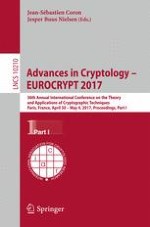2017 | OriginalPaper | Buchkapitel
Unconditional UC-Secure Computation with (Stronger-Malicious) PUFs
verfasst von : Saikrishna Badrinarayanan, Dakshita Khurana, Rafail Ostrovsky, Ivan Visconti
Erschienen in: Advances in Cryptology – EUROCRYPT 2017
Aktivieren Sie unsere intelligente Suche, um passende Fachinhalte oder Patente zu finden.
Wählen Sie Textabschnitte aus um mit Künstlicher Intelligenz passenden Patente zu finden. powered by
Markieren Sie Textabschnitte, um KI-gestützt weitere passende Inhalte zu finden. powered by
Abstract
-
In this work, we go beyond this seemingly tight result, by allowing any adversary to create stateful PUFs with a-priori bounded state. This relaxes the restriction on the power of the adversary (limited to stateless PUFs in previous feasibility results), therefore achieving improved security guarantees. This is also motivated by practical scenarios, where the size of a physical object may be used to compute an upper bound on the size of its memory.
-
As a second contribution, we introduce a new model where any adversary is allowed to generate a malicious PUF that may encapsulate other (honestly generated) PUFs within it, such that the outer PUF has oracle access to all the inner PUFs. This is again a natural scenario, and in fact, similar adversaries have been studied in the tamper-proof hardware-token model (e.g., Chandran et. al. (Eurocrypt 2008)), but no such notion has ever been considered with respect to PUFs. All previous constructions of UC secure protocols suffer from explicit attacks in this stronger model.
